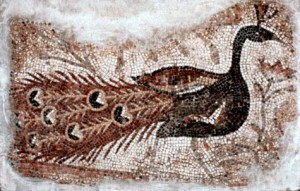On Church Fathers and Peacock Flesh… November 8, 2010
Author: Beach Combing | in : Ancient , trackbackBeachcombing doesn’t much care for the greatest Church Father of them all, Augustine. Perhaps its what ‘the Confessor’ did to his mother and his concubine. Perhaps it is his rather smug treatment of Britain’s first fanatic, Pelagius. Perhaps it is his Latin that is so tiresomely balanced and his apparently imbalanced thinking. But Beachcombing must confess to enjoying the moments when the natural scientist in Augustine appears: hammering the Bible into classical learning like so many nails in the coffin of knowledge.
Augustine on the shape of the world…
Augustine examining the tooth of a giant (a dinosaur?)…
Augustine on the quality of fire…
Or what about, to keep up with the bird theme that has dominated Beachcombing’s mind in the last couple of weeks, Augustine on the peacock?
Beachcombing’s darling wife, Mrs B., did her doctorate in an institute where peacocks wandered aimlessly around Renaissance grounds. Beachcombing knows then, from first-hand experience, that peacocks walk in a rather foolish fashion, that they make an appalling noise when they squawk, that they eat anything – the goats of the avian world, that they are rude to passers-by: and he has been reliably told that they don’t even taste very nice.
However, they have that extraordinary tail that opens to encores, not least for the colours and the fact that it seems to have eyes there: Flannery O Connor had one of her priestly characters exclaim, on seeing the opening tail: ‘Christ will come like that!’
The combination of the useless and unattractive with the rainbow posterior meant that peacocks were always going to go far in the human mind. It is certainly unsurprising that the peacock was frequently carved into stone by early Christians who saw the bird as a symbol of immortality. Beachcombing knows of one peacock mosaic under a church that takes his breath away and they are forever strutting into renaissance paintings not least those by Fra Angelico.
It was, of course from out of the Christian symbol bag that Augustine took the peacock and presented it to bemused posterity in his City of God – possibly the most intimidating book ever written. Augustine is, in this passage, arguing against the fact that human flesh would decay in hellfire.
For who but God the Creator of all things has given to the flesh of the peacock its antiseptic property? This property, when I first heard of it, seemed to me incredible; but it happened at Carthage that a bird of this kind was cooked and served up to me, and, taking a suitable slice of flesh from its breast, I ordered it to be kept, and when it had been kept as many days as make any other flesh stinking, it was produced and set before me, and emitted no offensive smell. And after it had been laid by for thirty days and more, it was still in the same state; and a year after, the same still, except that it was a little more shrivelled, and drier. [21, 4]
Quis enim nisi Deus creator omnium dedit carni pauonis mortui ne putesceret? Quod cum auditu incredibile uideretur, euenit ut apud Carthaginem nobis cocta apponeretur haec auis, de cuius pectore pulparum, quantum uisum est, decerptum seruari iussimus; quod post dierum tantum spatium, quanto alia caro quaecumque cocta putesceret, prolatum atque oblatum nihil nostrum offendit olfactum. Itemque repositum post dies amplius quam triginta idem quod erat inuentum est, idemque post annum, nisi quod aliquantum corpulentiae siccioris et contractioris fuit.
If God can preserve peacock flesh then why not human flesh in hellfire… QED! Augustine has established a proof for eternal punishment by hiding some fowl meat in his cellar: Beachcombing particularly likes ‘I ordered it to be kept’ as if this act required more than keeping it out of reach of the African ants. If only science were so easy today…
This got Beachcombing wondering whether the peacock’s popularity among early Christians actually came down not to that tail – that among the material-suspicious, vanity-hating first Christians might have spoken against the bird. But rather to it’s non-decaying flesh. He has found though no references. As to whether peacock meat has these qualities or preservation – or more so than other fowl – Beachcombing leaves the ‘if’ and ‘why’ to his readers: drbeachcombing AT yahoo DOT com.



